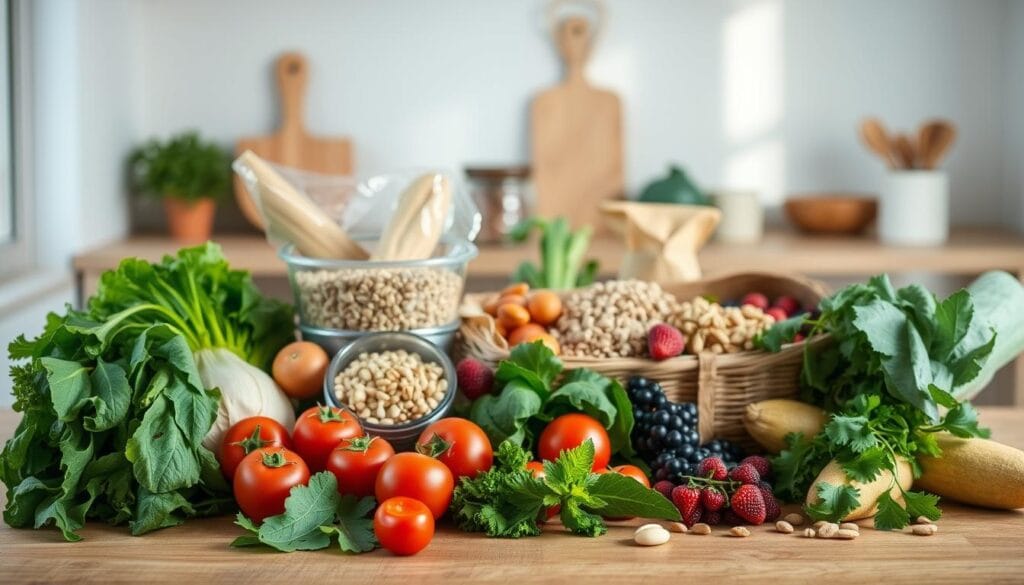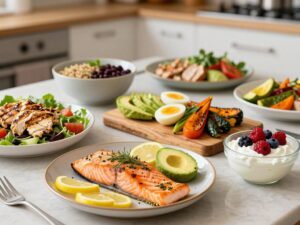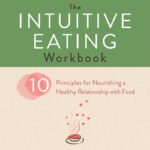As an Amazon Associate I earn from qualifying purchases.
Healthy Grocery List for Clean Eating
Grocery shopping can be a daunting task, especially when you’re trying to make healthier choices. With so many tempting treats and processed foods on the shelves, it’s easy to get sidetracked. However, having a well-planned clean eating shopping list can be a game-changer.
By sticking to a healthy grocery list, you can avoid unhealthy food choices and focus on nutritious foods that nourish your body. This simple yet effective approach can help you develop sustainable eating habits and transform your kitchen into a haven of wholesome goodness.
Key Takeaways
- Develop a well-planned shopping list to avoid unhealthy food choices
- Focus on nutritious foods that nourish your body
- Create sustainable eating habits with a clean eating approach
- Transform your kitchen into a haven of wholesome goodness
- Make grocery shopping a simpler and more enjoyable experience
Why a Grocery List Helps You Eat Healthier
A well-planned grocery list is essential for making healthier food choices. By deciding in advance what to buy, you can avoid the pitfalls of impulse shopping and ensure that your pantry is stocked with nutritious options.
Reducing Impulse Purchases
One of the primary benefits of having a grocery list is that it helps reduce impulse buys, which are often unhealthy. When you shop with a clear plan, you’re less likely to be swayed by tempting treats or processed foods. This not only saves you money but also helps keep your diet on track.
Studies have shown that shoppers who stick to their lists tend to make healthier choices and avoid unnecessary purchases. By being more intentional with your shopping, you can create a healthier eating environment at home.
Ensuring Nutritional Balance
A well-crafted grocery list also ensures that you’re getting a balanced mix of nutrients. By including a variety of whole foods, such as fruits, vegetables, whole grains, and lean proteins, you can ensure that your diet is rich in essential vitamins and minerals.
| Nutrient | Food Sources | Health Benefits |
|---|---|---|
| Protein | Lean meats, fish, eggs, legumes | Muscle repair, satiety |
| Fiber | Whole grains, fruits, vegetables | Digestive health, satiety |
| Healthy Fats | Nuts, seeds, avocados, olive oil | Heart health, nutrient absorption |
The Benefits of Clean Eating
Focusing on clean eating can be a pivotal step towards achieving better health and wellness. By incorporating a clean eating shopping list into your routine, you can ensure that your diet is rich in healthy food essentials.
Clean eating is more than just a diet; it’s a lifestyle choice that promotes overall health by emphasizing whole, unprocessed foods. This approach to eating helps in eliminating unhealthy ingredients and additives, thereby supporting a healthier body and mind.
Improved Energy and Wellness
One of the significant benefits of clean eating is the improvement in energy levels and overall wellness. By consuming nutrient-dense foods, the body receives the necessary fuel to function optimally. This leads to enhanced physical performance and mental clarity.
Weight Management Benefits
Clean eating also plays a crucial role in weight management. By focusing on whole foods and avoiding processed and high-calorie foods, individuals can better manage their weight. This approach to eating encourages a balanced diet that supports healthy weight goals.
Reduced Processed Food Consumption
Another key benefit of clean eating is the reduction in processed food consumption. Processed foods are often high in unhealthy fats, sugars, and salts. By minimizing these foods, individuals can significantly improve their diet and reduce the risk of chronic diseases.
By adopting a clean eating lifestyle, individuals can experience these benefits and more, leading to a healthier and more balanced life.
How to Shop the Perimeter of the Store
Most grocery stores are laid out in a similar manner, with the freshest and most wholesome foods typically located on the perimeter. This strategic layout is not coincidental; it’s designed to encourage healthier shopping habits by making fresh produce, meats, dairy products, and bakery items more accessible. By focusing on the perimeter, you can efficiently compile a healthy grocery list that aligns with your clean eating goals.
Understanding Store Layouts
Grocery stores are typically organized with the fresh produce section near the entrance, followed by other perimeter departments like meat, seafood, dairy, and bakery. This layout encourages customers to fill their carts with nutrient-dense foods before they reach the center aisles, which often contain processed and packaged items. Understanding this layout is key to making informed decisions about what to buy for healthy meals.
| Department | Typical Location | Typical Products |
|---|---|---|
| Produce | Perimeter, near entrance | Fruits, Vegetables |
| Meat and Seafood | Perimeter | Fresh Meats, Fish, Poultry |
| Dairy | Perimeter | Milk, Cheese, Yogurt, Eggs |
Exceptions Worth Making in Center Aisles
While the perimeter shopping strategy is effective, there are instances where venturing into the center aisles is necessary. Some center aisles contain healthy staples like whole grains, canned beans, and nuts. It’s essential to remain focused on your healthy grocery list and avoid impulse buys, even in these sections. Look for products that are low in added sugars, salt, and unhealthy fats, and high in nutrients.
Creating Your Healthy Grocery List for Clean Eating
To eat clean, you need to start with a clean grocery list that focuses on whole, nutrient-dense foods. This list will serve as your guide when navigating the grocery store, helping you make healthier choices.
Effective list creation begins with
Planning Based on Weekly Meals
. Before you go shopping, plan out your meals for the week. This approach ensures that you buy only what you need, reducing food waste and saving you money. Consider your schedule and choose meals that are quick and easy for busy days and more elaborate for days when you have more time.
When planning meals, focus on incorporating a variety of foods to ensure you’re getting a broad range of nutrients. For instance, you can start with a list of your favorite healthy food essentials like lean proteins, seasonal vegetables, and whole grains, and then build your meals around these items.
Organizing Your List by Department
Once you have your meal plan, organize your grocery list by categorizing items by the store department where they can be found. This strategy streamlines your shopping process, making it more efficient. For example, group together produce items, dairy products, and meats.
Here’s an example of how you can organize your list:
- Produce: Fresh fruits and vegetables
- Dairy/Eggs: Milk, yogurt, eggs, and cheese
- Meat/Seafood: Chicken, beef, fish, and plant-based proteins
- Grains: Whole grain bread, pasta, and rice
By organizing your list in this manner, you’ll be able to navigate the store more efficiently, ensuring that you don’t miss essential items and reducing the likelihood of impulse buys.
Fresh Produce: The Foundation of Clean Eating
Embarking on a clean eating journey begins with understanding the pivotal role of fresh produce. Fresh fruits, vegetables, herbs, and greens are not only packed with essential nutrients but also add variety and flavor to meals, making healthy eating a delightful experience.
When it comes to stocking a healthy grocery list, fresh produce should be at the top. The benefits of incorporating a variety of fresh produce into your diet are numerous, from providing vital vitamins and minerals to supporting overall health and wellness.
Seasonal Vegetables to Prioritize
Seasonal vegetables are not only more flavorful but also more nutritious and environmentally friendly. Some seasonal vegetables to prioritize include:
- Leafy Greens like kale and spinach, rich in iron and antioxidants.
- Cruciferous Vegetables such as broccoli and cauliflower, known for their cancer-fighting properties.
- Root Vegetables like carrots and beets, high in fiber and vitamins.
By focusing on seasonal produce, you can ensure you’re getting the best quality while supporting local farmers.
Fruits for Natural Sweetness
Fruits are a great way to satisfy your sweet tooth without reaching for processed snacks. Some fruits to include in your healthy grocery list are:
- Berries, rich in antioxidants and fiber.
- Citrus Fruits like oranges and lemons, high in vitamin C.
- Apples, a good source of fiber and antioxidants.
Incorporating a variety of fruits into your diet can add natural sweetness and a burst of flavor to your meals.
Herbs and Greens for Flavor and Nutrition
Herbs and greens not only add flavor to dishes but are also packed with nutrients. Some healthy options include:
- Fresh Herbs like basil and cilantro, rich in antioxidants.
- Greens such as arugula and spinach, high in vitamins and minerals.
Using herbs and greens in your cooking can enhance the nutritional value and flavor of your meals, making healthy eating enjoyable and sustainable.
By focusing on fresh produce, you’re taking a significant step towards clean eating and a healthier lifestyle. Remember, a well-stocked kitchen starts with a solid foundation of fresh, seasonal produce.
Whole Grains for Sustained Energy
Embracing whole grains can significantly enhance your dietary quality, offering sustained energy and supporting clean eating habits. Unlike refined grains, whole grains include the bran, germ, and endosperm, providing a rich source of fiber, vitamins, and minerals.
Whole grains are an essential component of a clean eating shopping list. They not only provide sustained energy but also support overall health and well-being. By incorporating a variety of whole grains into your meals, you can ensure you’re getting a broad range of nutrients.
Ancient Grains Worth Trying
Ancient grains like quinoa, Kamut, and spelt are gaining popularity due to their nutritional profile and versatility in cooking. Quinoa, for instance, is a complete protein, making it an excellent option for vegetarians and vegans. These grains can add variety to your meals and are a great addition to your healthy meal planning.
- Quinoa
- Kamut
- Spelt
- Buckwheat
Bread and Pasta Alternatives
For those who enjoy bread and pasta, switching to whole grain alternatives can make a significant difference in your diet. Whole grain bread and pasta are made from flour that includes the entire grain, offering more fiber and nutrients compared to their refined counterparts. Look for products that are labeled as “100% whole grain” to ensure you’re getting the most nutritional benefits.
Some popular alternatives include whole wheat bread, whole grain pasta, and products made from ancient grains like quinoa or Kamut. These alternatives can be used in place of traditional bread and pasta in most recipes, making it easier to adopt a clean eating lifestyle.
Lean Proteins for Muscle Health
Incorporating lean proteins into your diet is crucial for maintaining muscle health and overall well-being. Lean proteins are essential for building and repairing muscle tissue, making them a vital component of a healthy grocery list.
Animal-Based Protein Options
Animal-based proteins are a rich source of essential amino acids necessary for muscle repair and growth. Some of the best animal-based protein options include lean meats like chicken breast, turkey, and lean cuts of beef. Fish and poultry are also excellent choices due to their high protein content and lower saturated fat levels.
For example, a 3-ounce serving of chicken breast contains about 26 grams of protein. Incorporating these proteins into your meals can be as simple as grilling chicken or baking fish.
Plant-Based Protein Sources
For those following a plant-based diet, there are numerous protein-rich foods that can support muscle health. Legumes, such as lentils and chickpeas, are not only high in protein but also rich in fiber. Other excellent plant-based protein sources include tofu, tempeh, and seitan.
Nuts and seeds, such as almonds and chia seeds, also contribute to daily protein intake. A well-planned plant-based diet can provide all the necessary protein for muscle health.
Seafood Selections for Omega-3s
Seafood is an excellent source of lean protein and is particularly rich in omega-3 fatty acids, which are crucial for heart health and reducing inflammation. Fatty fish like salmon, mackerel, and sardines are among the best seafood choices for omega-3s.
Including a variety of seafood in your diet can enhance muscle health and overall nutrition. For instance, a serving of grilled salmon provides not only protein but also a significant amount of omega-3s.
| Protein Source | Protein Content per 3 oz Serving | Omega-3 Content |
|---|---|---|
| Chicken Breast | 26 grams | Low |
| Salmon | 20 grams | High |
| Lentils | 9 grams | Low |
| Tofu | 9 grams | Low |
In conclusion, a balanced diet that includes a variety of lean proteins is essential for maintaining muscle health. Whether you prefer animal-based or plant-based proteins, incorporating these foods into your healthy grocery list can significantly enhance your overall nutrition and support your fitness goals.
Healthy Fats That Support Your Body
Healthy fats play a significant role in supporting bodily functions and enhancing the quality of your meals. They are essential for absorbing vitamins, maintaining healthy skin, and supporting heart health. Incorporating the right types of healthy fats into your diet can make a significant difference in your overall wellness.
Oils and Cooking Fats
Choosing the right oils and cooking fats is vital for healthy eating. Avocado oil and olive oil are excellent choices due to their high levels of monounsaturated fats, which can help lower bad cholesterol levels. Other healthy options include coconut oil for its medium-chain triglycerides (MCTs) and ghee for its nutrient-rich profile.
- Avocado oil for high-heat cooking
- Olive oil for dressings and low-heat cooking
- Coconut oil for baking and adding MCTs
Nuts and Seeds
Nuts and seeds are not only a good source of healthy fats but also provide protein, fiber, and various essential minerals. Almonds, walnuts, and chia seeds are particularly beneficial. They can be enjoyed as snacks, added to meals, or used as toppings for salads and yogurt.
- Almonds for vitamin E and magnesium
- Walnuts for omega-3 fatty acids
- Chia seeds for fiber and antioxidants
Avocados and Other Whole Food Fats
Whole foods like avocados are rich in healthy fats and offer numerous nutritional benefits. Avocados are a rich source of monounsaturated fats, fiber, and various vitamins and minerals. Other whole food fats include fatty fish, which are high in omega-3 fatty acids, and full-fat dairy products, which provide a mix of saturated and unsaturated fats.
When shopping for healthy fats, consider the following tips to enhance your clean eating grocery list:
- Opt for cold-pressed oils
- Choose unsalted nuts and seeds
- Select ripe avocados for the best nutritional benefits
Pantry Staples for Clean Eating
Building a healthy grocery list begins with pantry staples that are rich in nutrients and low in processed ingredients. A well-stocked pantry is essential for clean eating, as it provides the foundation for preparing healthy meals. By focusing on whole foods and minimally processed items, you can create a pantry that supports your overall health and well-being.
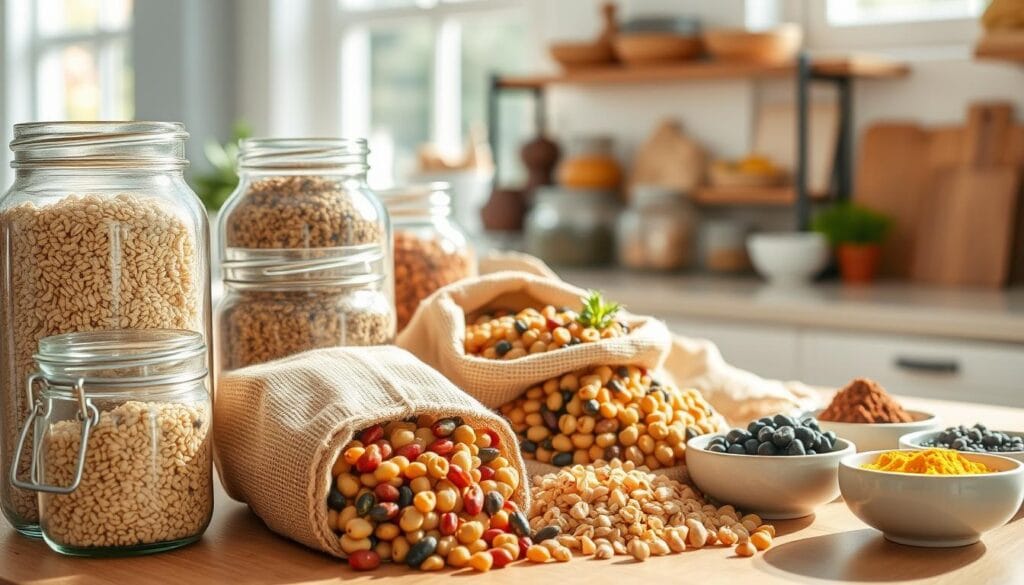
Beans and Legumes
Beans and legumes are a crucial part of a clean eating pantry. They are rich in protein, fiber, and various vitamins and minerals. Examples include black beans, chickpeas, lentils, and kidney beans. These versatile ingredients can be used in a variety of dishes, from soups and stews to salads and main courses. Incorporating beans and legumes into your diet can help support heart health and provide sustained energy.
Herbs, Spices, and Natural Seasonings
Herbs, spices, and natural seasonings are essential for adding flavor to your meals without relying on salt and sugar. Some staples include turmeric, ginger, cumin, and basil. These ingredients not only enhance the taste of your food but also offer various health benefits. For example, turmeric contains curcumin, which has anti-inflammatory properties, while ginger has been shown to aid digestion.
When selecting herbs and spices, opt for organic and non-GMO options to avoid unnecessary additives. You can also explore different seasoning blends that are free from artificial ingredients.
Canned and Jarred Goods Worth Buying
Canned and jarred goods can be a convenient and nutritious addition to your pantry. Look for items like canned tomatoes, beans, and tuna that are low in sodium and free from added preservatives. Jarred goods such as marinara sauce, salsa, and pickles can add flavor to your meals. When choosing canned and jarred goods, be sure to read labels carefully to avoid products with added sugars and unhealthy fats.
Some other worth-while options include coconut milk, artichoke hearts, and roasted red peppers. These ingredients can be used to create a variety of healthy and delicious meals.
Healthy Snacks to Keep You Satisfied
Choosing the right healthy snacks can make all the difference in your overall eating habits. Snacking is not just about curbing hunger; it’s about providing your body with the nutrients it needs to function optimally. A well-stocked snack arsenal can help you avoid unhealthy impulse choices and stay on track with your clean eating goals.
Portable Protein Options
Protein-rich snacks are essential for maintaining energy levels and supporting muscle health. Consider portable protein options like hard-boiled eggs, Greek yogurt, or protein-rich nuts and seeds. These snacks are not only convenient but also provide a boost of protein to keep you satisfied between meals.
Fiber-Rich Snack Ideas
Fiber is crucial for digestive health and can help keep you feeling fuller for longer. Incorporate fiber-rich snack ideas such as fresh fruits, carrot sticks with hummus, or a handful of almonds into your daily routine. These snacks are not only nutritious but also support healthy digestion.
Smart Alternatives to Common Processed Snacks
Ditching processed snacks can be challenging, but there are plenty of smart alternatives available. For instance, swap potato chips for baked sweet potato chips or choose air-popped popcorn seasoned with herbs instead of buying pre-packaged flavored popcorn. Being mindful of your snack choices can significantly impact your overall health and well-being.
What to Avoid on Your Healthy Grocery List
When it comes to stocking your pantry with healthy food essentials, it’s equally important to know what to avoid. A well-curated healthy grocery list not only includes nutritious foods but also steers clear of products that can derail your clean eating goals.
Hidden Sources of Added Sugar
One of the primary things to avoid on your grocery list is products with hidden sources of added sugar. Many seemingly healthy foods, such as yogurt, granola, and even some bread products, can contain high amounts of sugar. Always check the ingredient list for terms like sucrose, high fructose corn syrup, and other sugar derivatives.
Being aware of these hidden sugars can help you make better choices and reduce your overall sugar intake, which is crucial for maintaining a healthy diet.
Misleading “Health Food” Marketing
Another pitfall to watch out for is misleading “health food” marketing. Some products are packaged to appear healthy but actually contain unhealthy ingredients. Terms like “natural” and “organic” are not always synonymous with healthy. It’s essential to read beyond the packaging and check the ingredient list and nutrition label.
By being cautious of these marketing tactics, you can avoid falling into the trap of purchasing unhealthy products that don’t align with your clean eating goals.
Budget-Friendly Healthy Shopping Tips
Eating clean doesn’t have to break the bank; here are some budget-friendly tips for healthy grocery shopping. Adopting a clean eating lifestyle is not just about the food you buy, but also about how you shop for it.
To start, it’s essential to be mindful of your shopping habits and make informed decisions. One of the key strategies is to plan your shopping trip. This includes making a list and sticking to it, as well as considering the timing of your shopping trip to avoid impulse buys.
Seasonal Shopping Strategies
Shopping for produce that’s in season is a great way to save money. Produce that’s in season is often cheaper because it’s more abundant and requires less complex logistics.
For example, buying berries in the summer or apples in the fall can be more cost-effective. You can also consider shopping at local farmers’ markets or joining a community-supported agriculture (CSA) program to get fresh, seasonal produce.
Bulk Buying Benefits
Buying in bulk can be another cost-effective strategy, especially for non-perishable items like grains, nuts, and canned goods.
| Item | Bulk Price | Regular Price | Savings |
|---|---|---|---|
| Quinoa (20 lbs) | $40 | $60 (2 lbs x $3) | 33% |
| Almonds (5 lbs) | $25 | $40 (1 lb x $8) | 37.5% |
| Canned Beans (12-pack) | $10 | $18 (12 x $1.5) | 44% |
Store Brand vs. Name Brand Considerations
Another way to save money is by opting for store-brand products instead of name-brand products. Many store-brand products are of similar quality but at a lower price point.
For instance, store-brand canned goods, grains, and even some dairy products can be just as good as their name-brand counterparts but at a fraction of the cost.
By implementing these strategies, you can maintain a clean eating diet without breaking the bank. The key is to be informed, plan ahead, and make smart choices at the store.
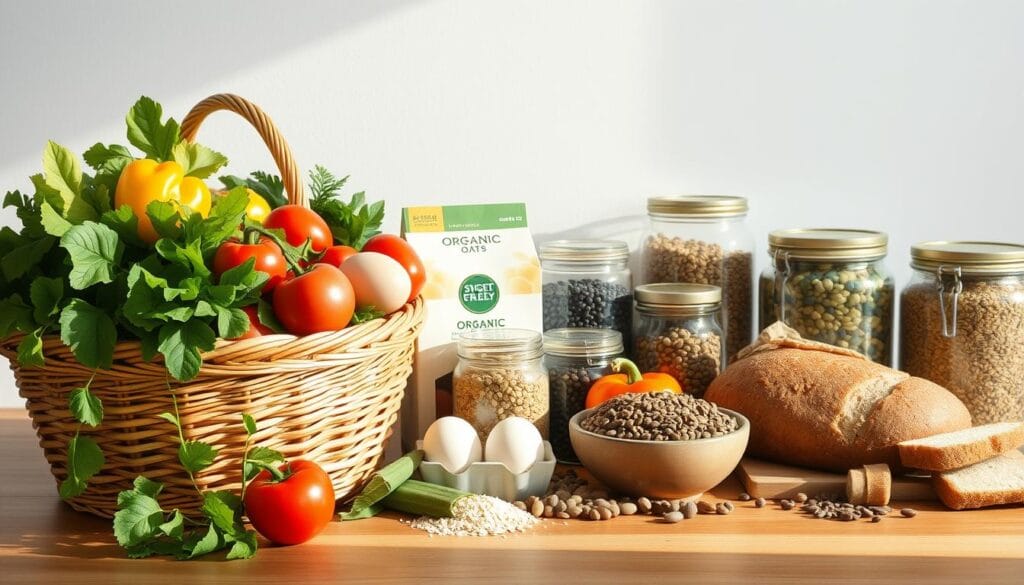
Sample 1-Week Healthy Grocery List
A healthy grocery list is your roadmap to a week’s worth of nutritious meals and snacks. Having a well-planned list ensures that you stay on track with your clean eating goals. Here’s a sample 1-week healthy grocery list to get you started.
Breakfast Essentials
Starting your day with a nutritious breakfast is crucial. Some breakfast essentials include:
- Fresh berries
- Almond milk or other low-fat milk alternatives
- Whole grain cereals or oats
- Eggs
- Nuts and seeds like walnuts or chia seeds
These items can be used to make a variety of healthy breakfast dishes, from oatmeal with fruit to scrambled eggs with spinach.
Lunch and Dinner Components
For lunch and dinner, focus on whole foods that provide a balance of protein, healthy fats, and complex carbohydrates. Some key components include:
- Lean proteins like chicken breast, turkey, or fish
- A variety of colorful vegetables for different vitamins and minerals
- Quinoa or brown rice for complex carbohydrates
- Canned beans or lentils for plant-based protein
- Healthy oils like olive oil for cooking
These ingredients can be combined in numerous ways to create healthy, delicious meals. For example, grilled chicken with roasted vegetables and quinoa makes for a well-rounded dinner.
Snack and Treat Options
Healthy snack and treat options are essential for curbing cravings and maintaining energy levels. Consider stocking up on:
- Fresh fruit like apples or oranges
- Nuts and seeds like almonds or pumpkin seeds
- Dried fruit without added sugars
- Dark chocolate in moderation
- Homemade trail mix made with nuts, seeds, and dried fruit
Conclusion: Shop Smart, Eat Well
Creating a clean eating shopping list is a crucial step towards a healthier lifestyle. By focusing on whole foods, lean proteins, and healthy fats, you can ensure that your diet is rich in nutrients. The key is to shop smart and avoid processed foods that can derail your healthy eating goals.
With a well-planned clean eating shopping list, you’ll be able to stock your pantry with what to buy for healthy meals, making it easier to prepare nutritious dishes. By shopping the perimeter of the store, selecting seasonal produce, and incorporating whole grains, lean proteins, and healthy fats into your diet, you’ll be well on your way to achieving your health and wellness goals.
Start applying the knowledge gained from this guide to make informed choices at the grocery store. A healthy diet is just a shopping trip away, and with the right mindset and a clean eating shopping list, you can take control of your nutritional well-being.
FAQ
What are the essentials for a healthy grocery list?
A healthy grocery list should include fresh produce, whole grains, lean proteins, healthy fats, and pantry staples like beans and legumes, and herbs and spices.
How do I plan my grocery list for clean eating?
To plan your grocery list for clean eating, start by planning your meals for the week, then make a list of the ingredients you need, and organize them by store department.
What are some healthy alternatives to common processed snacks?
Healthy alternatives to common processed snacks include portable protein options like nuts and seeds, fiber-rich snacks like fruits and vegetables, and smart alternatives like air-popped popcorn or energy balls made with oats and nuts.
How can I shop for groceries on a budget while still eating healthy?
To shop for groceries on a budget while still eating healthy, consider shopping seasonally, buying in bulk, and opting for store-brand products over name-brand products.
What are some common hidden sources of added sugar that I should avoid?
Common hidden sources of added sugar include processed foods like sauces, condiments, and baked goods, as well as seemingly healthy foods like flavored yogurts and granola.
How can I ensure I’m getting a nutritional balance in my diet?
To ensure you’re getting a nutritional balance in your diet, focus on including a variety of whole foods in your grocery list, such as fruits, vegetables, whole grains, lean proteins, and healthy fats.
What are some benefits of shopping the perimeter of the store?
Shopping the perimeter of the store can help you focus on whole, unprocessed foods like produce, meats, and dairy products, and avoid processed and packaged foods often found in the center aisles.
Can I still eat healthy if I have a busy schedule?
Yes, you can still eat healthy even with a busy schedule by planning your meals, shopping for groceries in advance, and preparing healthy snacks and meals that can be easily taken on the go.
Amazon and the Amazon logo are trademarks of Amazon.com, Inc or it's affiliates.
Related Posts
- Making Healthy Eating Affordable
Making Healthy Eating Affordable Tips for Meal Planning, Grocery Shopping, and Cooking at Home When…
- Best Tips to Stop Stress Eating
Best Tips to Stop Stress Eating In today's fast-paced world, stress has become an inevitable…
- Homemade Healthy Granola Recipe
Homemade Healthy Granola Recipe The Ultimate Healthy Granola Delight In the pursuit of a wholesome…

